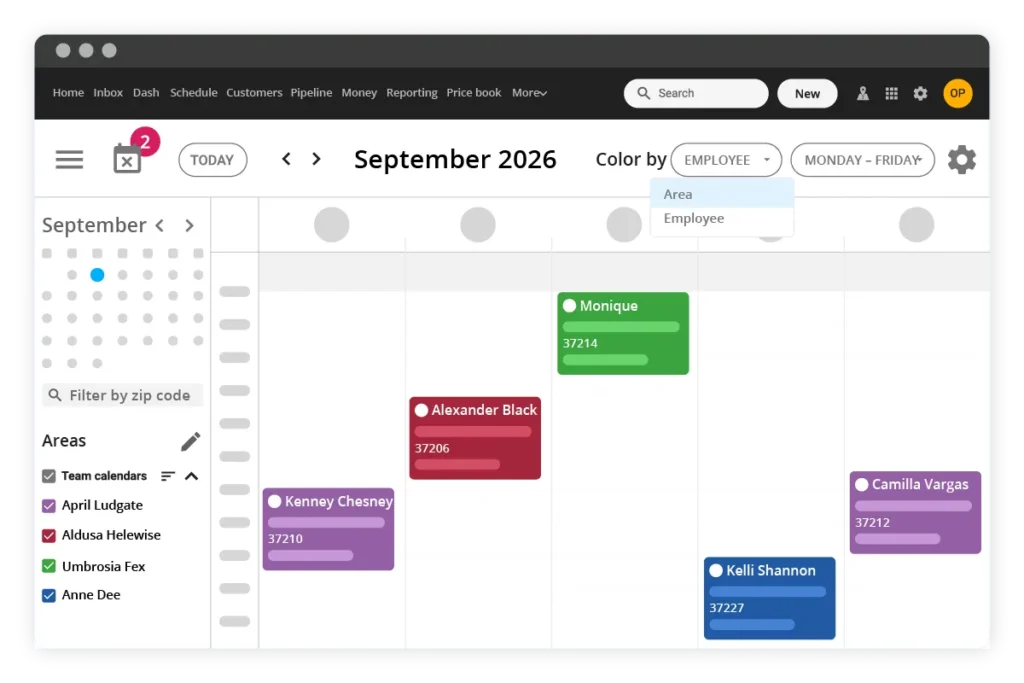
In the trades, every hour counts – but what if rethinking the workweek could boost productivity, reduce burnout, and keep your team happier? We are generally familiar with the traditional five-day, eight-hour-per-day work week. But what if there were better solutions available?
The HouseCall Pro community was asked about alternatives to the traditional work schedule. How are those working 4x10s, 4x8s, and 5x7s doing compared to the standard? How has it impacted business outcomes, efficiency, and overall employee satisfaction? Check out the alternative scheduling options below and share your experiences with testing different schedules.
Find Out Which Workweeks Maximize Efficiency
Why Having the Right Workweek Structure Could Make or Break Your Business
The traditional 5×8/40-hour workweek has become a staple for many businesses. It just became the way of life, and most businesses adhere to it simply out of tradition. As we continue to explore the different ways to improve productivity and reduce employee turnover, alternative scheduling options are becoming more commonly implemented.
Burnout is one of the biggest concerns with the traditional workweek. That kind of schedule, generally on a 9-5 basis, means that workers have less time each day to handle their lives away from work. Weekends are used to catch up on chores, shopping, and laundry, meaning there is less time to actually rest from the work week.
“Hours in = production out. A challenge with chasing maximum efficiency generally results in higher worker burnout/turnover.” – Anonymous
Employee retention is another challenge facing modern service businesses. Workers are looking for the best possible fit, and sometimes that means going elsewhere. Businesses that aren’t willing to change with the times will often lose their best workers. Employees suffering from burnout will focus more on leaving than doing the job well.
The Case for Alternatives
Times are changing and the traditional five-day, eight-hour workday isn’t working for everyone. Truly great companies change with the times and make alterations when needed. There have been positive results from making the move to an alternative work week so far. Let’s take a look at moving to a 4×10 schedule, a 5×7 schedule, and staggering shifts.
The Case for a 4×10 Workweek in the Trades
“We’ve been doing 4x10s for a couple of years. Production went up about 9%, and it solves a ton of problems like rain-outs and needing extra hours to finish.” – Caleb Wininger
“Everyone loves it. They like the three days off to spend with family or handle errands without rush hour crowds.” – Travis Turner
How can more hours in a day be better in the long run? Well, for starters, there is no loss of income for workers. That’s a big one. But having that extra day off to spend with family, get errands done, or to just rest up can be a difference-maker for some.
There is greater day-to-day coverage with longer shifts, not to mention fewer interruptions or shift changes. For workers, it means creating a far better work-life balance. A happy worker is one who shows up each day to do their best. That’s what is best for business in the long run.
Why Businesses Are Switching to a 5×7 Workweek
For some companies, working five days a week may be non-negotiable. But working traditional 5×8 schedules can come with a lot of challenges. Even cutting just one hour per day from a worker’s schedule can help to improve productivity and reduce the risk of burnout.
“We’re the most profitable department in the company with the lowest turnover. I don’t think It’s a coincidence.” – Jon O’Brien
“It’s unconventional, but we found it works well when paired with a focus on efficiency and early finish times.” – Anonymous
Creating a shorter workday means improving focus on the tasks at hand. It also means being able to meet productivity and weekly output without having to make a drastic change. Finding that balance is one of the great challenges facing a service business. Making a minor change allows for benefits on both sides without a sizable shift.
Flexible or Staggered Shifts
“We stagger schedules to keep the business running seven days a week during the busy season. It’s a win for the team and the company.” – Caleb Wininger
Making the shift to different shift lengths may not be for every business. It depends on the size and makeup of the staff. That said, moving to staggered schedules can be a fantastic way to ensure that there is coverage 24 hours a day. That availability can pay dividends if you build a trustworthy, reliable reputation.
By staggering shifts, it allows for operations to run continuously. Even better, it means predictable hours for each worker rather than having to work “on-call” hours that could change on a whim. As important as it is to ensure productivity, worker satisfaction is critical when it comes to keeping talent in the picture.
Challenges and Considerations
Though you are likely to hear about the benefits of alternative scheduling, it isn’t all sunshine and rainbows. As is the case with virtually anything in business, there are upsides and downsides to consider. Here are the three most common challenges to offering alternative scheduling.
1. Client Scheduling Conflicts
“Some clients push back on early starts. We work around this by scheduling later for clients or handling shop tasks first.” – Travis Turner
Customers are all different. Though many may fall within “traditional” hours, there are going to be some that prefer an early start or being the last one of the night. Having the ability to meet those scheduling needs is what separates the wheat from the chaff.
With flexibility and improved communication, it is possible for your company to expand coverage. The challenge is having enough people on the payroll to staff in those positions, making it worth the expanded coverage in the first place. It is a bit of a dance to get to an optimal position, but it is possible to provide effective, productive 24/7 coverage.
2. Compliance and Breaks
“Legally, you may need to give more breaks for 10-hour shifts, depending on your location.” – Midnight Electric, LLC
There are regulations that must be taken into account when running a business with employees. They require breaks by law, and it can be a bit tougher to factor in when moving to alternative schedules. It takes a little more leg work to hammer down the necessary understanding of these requirements.
For instance, a 10-hour shift may require more breaks than an 8-hour shift. The less time spent by employees sitting on the sidelines, the more can be contributed to the business. Staggering shifts can be a great way to reduce that time lost and maximize productivity.
3. Emergency Coverage
“Only downfall is I have nobody on Fridays for emergency service calls.” – Travis Turner
Nights and weekends tend to be the most challenging when it comes to the service business. There are always going to be customers who have issues arise that can’t wait for traditional business hours. Having someone ready to go is a challenge that all service businesses face.
By introducing rotating shifts or potentially hiring specific team members for those emergency hours, it can improve the availability and overall customer satisfaction of the business. Work with team members to see who is comfortable working those hours and always garner feedback to make the necessary tweaks.
Some Structures Lead to Improved Productivity, Retention, and KPIs
Why make the move to a different work schedule in the first place? There are three major reasons why more companies are expanding their horizons and offering varying schedules to employees.
1. Improved Productivity
Production is the bottom line – literally. There are plenty of tools like voice solutions, invoicing software, scheduling, and others that help the business hum. But at the end of the day, employees keep things moving or grind them to a halt.
“Production went up about 9% over 5x8s with the same hours worked.” – Caleb Wininger
You may find that fewer days on the job improves productivity in employees. So long as the work is getting done, it shouldn’t matter how it gets done. Alternative schedules can potentially allow for better, more focused, uninterrupted work. That is what will benefit the bottom line most in the end.
2. Employee Satisfaction
Turning a profit is of course the goal of any business. But at the end of the day, the business is driven by its employees. Without a good team in your corner, things will fall apart. Finding a schedule that works best for the business will ultimately keep employees happier in the long run.
“The last three techs left their previous employer to join us because of our four-day workweek.” – George Haithcock
Alternative schedules can be a fantastic way to attract talent. Not being forced into a rigid work week means being able to diversify hires, fill out different schedules, and provide 24/7 coverage with enough members on the team. You may not need to shift to a company-wide work week, but some changes could prove beneficial for talent hiring and retention.
3. Cost Savings
“We saved 20% on vehicle expenses with a 4-day workweek.” – George Haithcock
Every business is looking to save money on the bottom line. Using advanced reporting will allow you to see where the biggest spending issues are, including whether a 5-day work week works better versus a 4-day work week.
One of the major benefits of four-day workweeks compared to a five-day work week is the reduction in certain expenses. Vehicle expenses can really add up depending on the business. Reducing those costs contributes to major savings over time, which can go into other areas of the business.
How to Structure Your Employee’s Workweek Schedules

1. Start Small
The best way to explore four-day workweek pros is to start small. Test out a single department or crew with different work weeks before implementing it on a company-wide scale. You may find that some departments have major 4-day work week pros while others do better working 5 days a week.
2. Communicate
Communication is critical in all areas of business. Talk about the changes, how they impact their work week, and whether they like the four- or five-day workweek. Scheduling software can also help meet specific preferences based on shift. Talking about it is a great way to find what works, change what doesn’t, and address any concerns.
3. Monitor KPIs
Making the switch is fine and well, but what good will it do if you don’t have the numbers to back it up? How can you really find out the benefits of a 5-day work week versus a 4-day work week? Track time, productivity, revenue, and turnover rates to find out where you’re having success and where things need tweaking.
4. Stay Flexible
Remember that not everyone is different. Some prefer a five-day work week while others feel great about going to four days. Listen to feedback from those who work 5 days a week versus 4, what they like and what they don’t, and consider the results of each.
5. Prioritize Breaks
Breaks are not only required by labor laws but they are appreciated by employees. Depending on shift length and time, there may be different requirements when it comes to breaks for a five-day workweek versus a four-day workweek. Contrast and compare to determine where you’re having success.
Now Over to You
When thought out, alternatives to the traditional 5-day work week can be beneficial. The beautiful thing is that work weeks don’t have to be universal. There are 4-day work week pros that benefit one company, while there are benefits of a 5-day work week for others. Making the move to 4x10s or 5x7s can help improve employee retention, reduce burnout, and improve productivity.
If you run a business, take the time to experiment with different workweek combinations. It takes time to find what best matches employee preferences and the needs of the business. Whether 5 days a week or switching to four works best will ultimately be up to you.
“The grass is always greener where you water it.” – Curits Maddox





